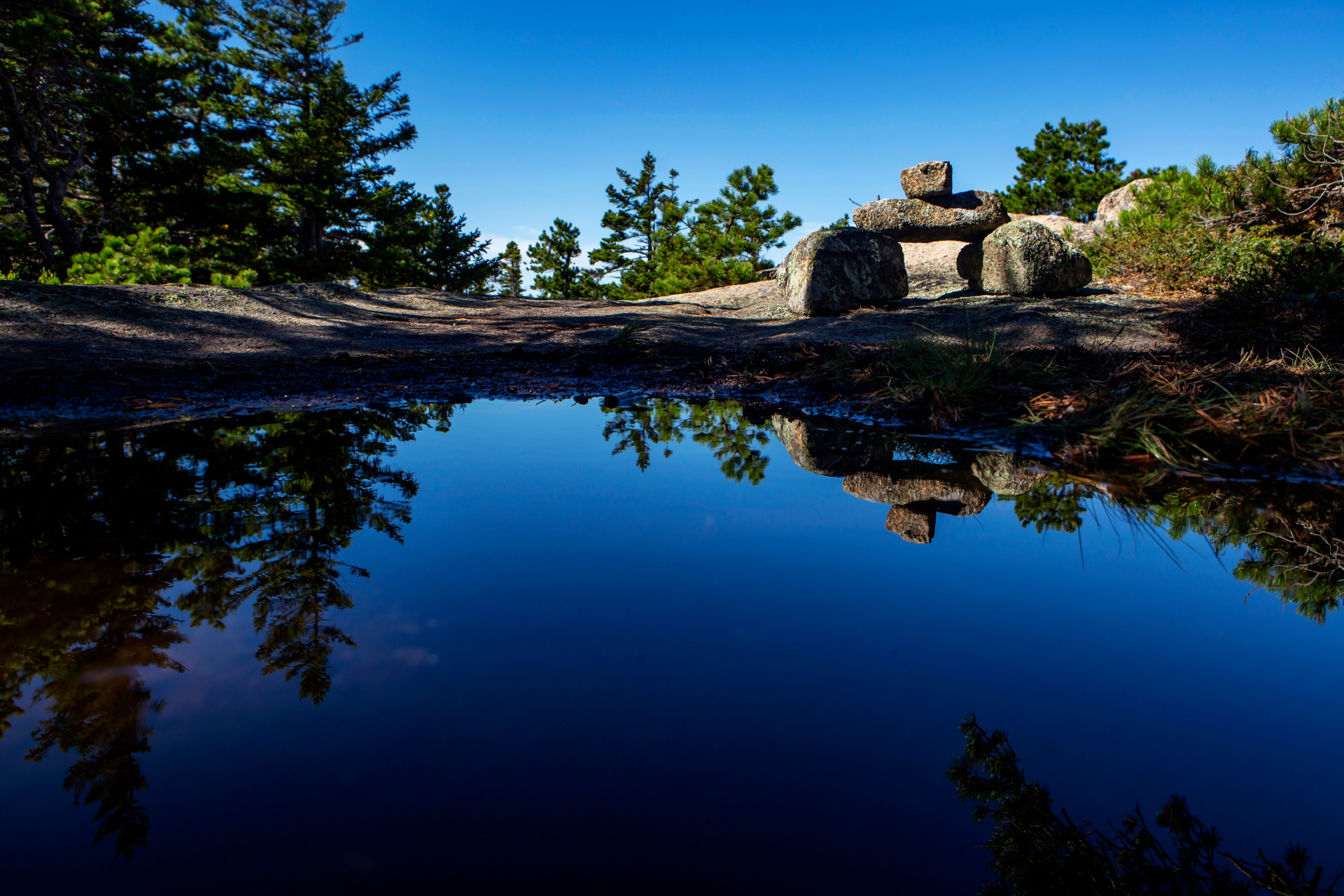Why We Care About Cairns
As trail markers, cairns keep hikers on the single route, protecting fragile subapline soil and vegetation. In foggy or stormy weather, they can be lifesavers.
December 18th, 2023
As trail markers, cairns keep hikers on the single route, protecting fragile subapline soil and vegetation. In foggy or stormy weather, they can be lifesavers.
December 18th, 2023
BY CHARLIE JACOBI
If you hike Acadia’s mountain trails, you’ll see them – piles of rock, marching up the mountain with you. Why are they there, and how were they built? Who maintains them?
Maybe you know the answers, maybe you don’t. And maybe you don’t care. But you should. As cairns go, so goes the mountain landscape.

A Bates cairn reveals the way down the Sargent East Cliffs Trail. (Photo by Ashley L. Conti/Friends of Acadia)
Cairns have likely marked human travel routes from time immemorial. The word is Scottish, and simply means “a pile of rocks.” For today’s trail maintainers, however, that definition is a major injustice. Cairns are carefully constructed stone trail markers used in treeless areas. Crews build traditional conical cairns on the same principles as a stone wall – each rock should overlap others, have three points of contact, and slope inward. The base and height of the cairns should be about equal. It takes a long time to build a stable, proper cairn, and lots of material must be available to choose from. All material is selected from loose rock on the ground. No rocks are removed from mountain soil.

Morning light illuminates Bates cairns down the Cadillac South Ridge Trail. The cairns guide hikers along the trail so they don’t end up lost off-trail and possibly trampling fragile vegetation. Win-win! (Photo by Ashley L. Conti/Friends of Acadia)
As trail markers, cairns keep hikers on the single route, protecting fragile subapline soil and vegetation. In foggy or stormy weather, they can be lifesavers, helping to keep one safely on the trail. Each is a critical function, protecting the mountain landscape and hikers.
Not all cairns have been built in the style of a cone. In the early 1900s, Acadia trail builder Waldron Bates introduced what we now call the Bates cairn. It consists of two large base stones supporting a mantel between them. A fourth rock, rests on top and, along with the base stones, points in the direction of the trail. Sometimes two layers of base rocks are used to gain height for added visibility.
For reasons unknown, traditional conical cairns (found all over New England’s high elevation trails) replaced many Bates cairns in Acadia, probable in the 1950s and 1960s.
However, because Acadia’s trails are important cultural resources, and the Bates cairn was once a defining feature contributing to the character of many trails – just like stone steps and retaining walls – it’s making a comeback on park trails. Also, it takes less time to find the right large rocks to construct stable Bates cairns, make them easier to build and maintain than traditional cairns.

Nikki Burtis, Friends of Acadia Stewardship Coordinator, left, and Steph Ley, Friends of Acadia Summit Steward Coordinator, repair a bates cairn on the Dorr Mountain North Ridge Trail. (Photo by Lily LaRegina/Friends of Acadia)
Ease in construction is important because Acadia hikers seem to have a never-ending tendency to tamper with cairns. Rocks are added or removed at will. Carefully built cairns mysteriously collapse. Additionally, cairns and rock graffiti in various forms appear from nowhere. Over a six-week period on one trail last summer, an average of one-third of the cairns were altered every five days. Much time, money, and energy is expended to undo this sort of damage. And tampering takes a toll on the mountain landscape.

A Bates cairn shows the way on a snow-covered Bald Peak Trail. (Photo by Ashley L. Conti/Friends of Acadia)
Visitors often remove rocks that are still embedded in the soil, opening the door for more soil loss. Topsoil and Acadia’s mountainsides may take hundreds of years to rebuild. Extra cairns can lead hikers astray, contributing to loss of vegetation and eventually further soil erosion, as well as to confusion, causing hikers to become lost and creating potential safety problems.
Rock graffiti and many visitor-built cairns degrade the natural mountain landscape we come to experience. Who wants to see mandalas on Sargent Mountain? Or see that T.S. loves M.E.?

A sharp-looking Bates cairn admires its reflection in a puddle on the Norumbega Mountain Trail in Acadia National Park. (Photo by Ashley L. Conti/Friends of Acadia)
Caring for cairns is caring for the mountain and for trail history, and it’s every hiker’s job. Pay attention when hiking. Look up to follow the cairns and blazes, and follow them closely, staying on rock ledge whenever possible. Do not add to or build cairns or other rock objects. Leave the mountain and the rocks as you found them. Let cairns age gracefully and add to the cultural landscape of the hiking trail system.
Stewardship begins when you care.
Story originally published in the 2005 spring issue of Friends of Acadia Journal:
At the time he wrote this in 2005, Charlie Jacobi was a natural resources specialist at Acadia National Park, working with Friends of Acadia Summit Stewards (then known as Ridge Runners) and volunteers to maintain Acadia’s cairns.
A handful of stewardship tips that’ll ensure you’re a standout steward in Acadia and every outdoor space you adventure in.
Stewardship Tips